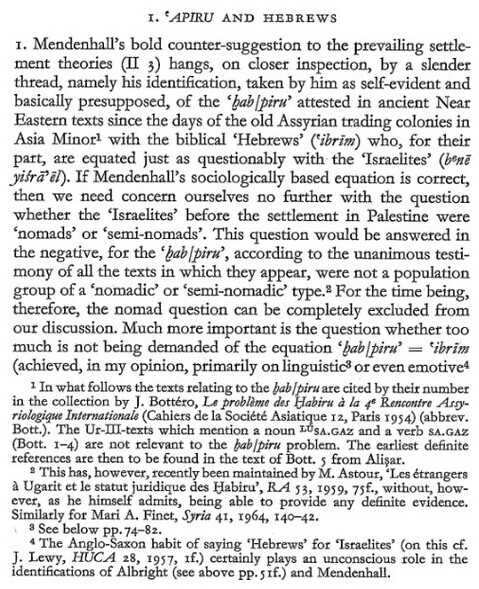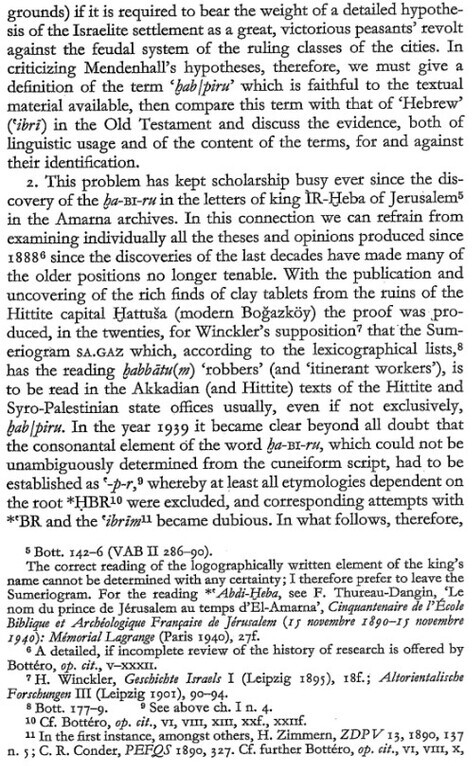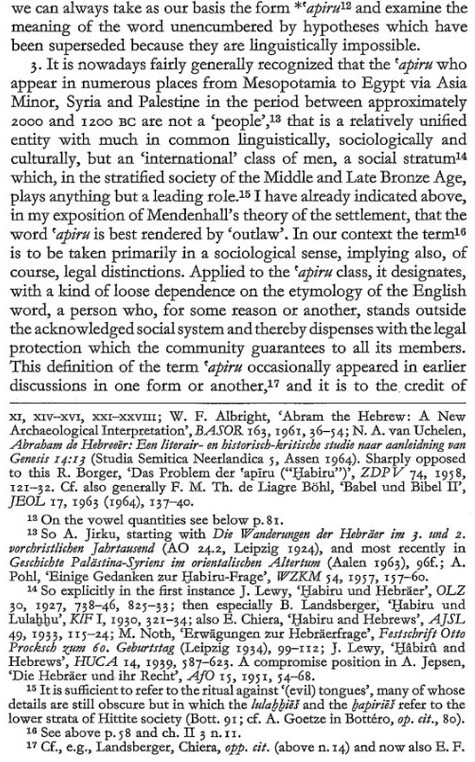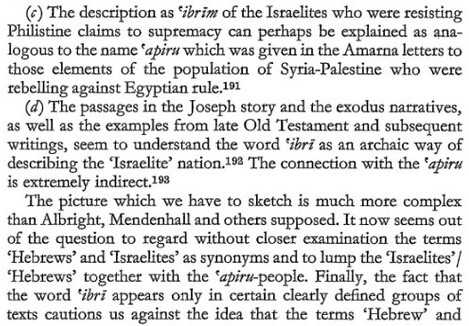|
Other Archaeological Sites / The Neolithic of the Levant (500 Page Book Online) The Habiru -- Hapiru -- Apiru Updated November 19th 2019 Habiru (sometimes written as Hapiru and more accurately as Apiru) is a term used in 2nd-millennium BCE texts throughout the Fertile Crescent for people variously described as rebels -- outlaws -- raiders -- mercenaries -- bowmen -- servants -- slaves and laborers (1)
(2) Apiru and the Hebrews: The Settlement of the Israelite Tribes in Palestine https://ancientneareast.tripod.com/PDF/Weippert_Apiru_and_the_Hebrews.pdf
(3) The Hebrew Conquest of Palestine by George Mendenhall
grounds) if it is required to bear the weight of a detailed hypothesis of the Israelite settlement as a great victorious peasants' revolt against the feudal system of the ruling classes of the cities. In criticizing Mendenhall's hypotheses therefore we must give a definition of the term 'hab|piru' which is faithful to the textual material available then compare this term with that of 'Hebrew' (ibrī) in the Old Testament and discuss the evidence both of linguistic usage and of the content of the terms for and against their identification. 2. This problem has kept scholarship busy ever since the discovery of the ha-BI-ru in the letters of king ĪR-Heba of Jerusalem in the Amarna archives. In this connection we can refrain from examining individually all the theses and opinions produced since 1888 since the discoveries of the last decades have made many of the older positions no longer tenable. With the publication and uncovering of the rich finds of clay tablets from the ruins of the Hittite capital Hattuša (modern Boğazköy) the proof was produced in the twenties for Winckler's supposition that the Sumeriogram SA.GAZ, which according to the lexicographical lists has the reading habbatu(m) 'robbers' (and 'itinerant workers'), is to be read in the Akkadian (and Hittite) texts of the Hittite and Syro-Palestinian state offices usually, even if not exclusively, 'hab|piru'. In the year 1939 it became clear beyond all doubt that the consonantal element of the word ha-BI-ru, which could not be unambiguously determined from the cuneiform script, had to be established as '-p-r, whereby at least all etymologies dependent on the root *HBR were excluded and corresponding attempts with *BR and the ibrim became dubious. In what follows therefore
we can always take as our basis the form *apiru and examine the meaning of the word unencumbered by hypotheses which have been superseded because they are linguistically impossible. 3. It is nowadays fairly generally recognized that the apiru who appear in numerous places from Mesopotamia to Egypt via Asia Minor -- Syria and Palestine in the period between approximately 2000 and 1200 BC are not a 'people' -- that is a relatively unified entity with much in common linguistically, sociologically and culturally -- but an 'international' class of men; a social stratum which, in the stratified society of the Middle and Late Bronze Age, plays anything but a leading role. I have already indicated above in my exposition of Mendenhall's theory of the settlement that the word apiru is best rendered by 'outlaw'. In our context the term is to be taken primarily in a sociological sense implying also, of course, legal distinctions. Applied to the apiru class it designates with a kind of loose dependence on the etymology of the English word, a person who for some reason or another stands outside the acknowledged social system and thereby dispenses with the legal protection which the community guarantees to all its members. This definition of the term apiru occasionally appeared in earlier discussions in one form or another and it is to the credit of
Mendenhall that he has defined it in this way within the context of his treatment of the Israelite settlement. In order to fit in with his conversion hypothesis however Mendenhall is obliged to lay too great an emphasis on the voluntary nature of the existence of the apiru. It seems to me that entry into this category of classless individuals must normally, as the texts seem to indicate between the lines, have been experienced as a misfortune, just as in the few cases in which we can observe the process of exclusion from ‘middle-class society', external pressure is the cause not free choice ...
12. With regard to the question of the identity of the apiru people of the ancient Near Eastern texts of the second millennium with the biblical Hebrews there emerges from our discussion of the two terms the following:
(c) The description as ibrim of the Israelites who were resisting Philistine claims to supremacy can perhaps be explained as analogous to the name apiru which was given in the Amarna letters to those elements of the population of Syria-Palestine who were rebelling against Egyptian rule. (d) The passages in the Joseph story and the exodus narratives as well as the examples from late Old Testament and subsequent writings seem to understand the word ibri as an archaic way of describing the ‘Israelite’ nation. The connection with the apiru is extremely indirect. The picture which we have to sketch is much more complex than Albright -- Mendenhall and others supposed. It now seems out of the question to regard without closer examination the terms ‘Hebrews’ and ‘Israelites’ as synonyms and to lump the two together with the apiru-people. Finally the fact that the word ibri appears only in certain clearly defined groups of texts cautions us against the idea that the terms ‘Hebrew’ and
‘Israelite’ are interchangeable at will. At the same time it is not possible either to regard the bené yisraél of the Old Testament settlement narratives simply as ibrim and apiru-people. Since in addition the apiru of the Amarna letters, as we have shown, do not fill the role which Mendenhall ascribes to them, his hypothesis of the Israelite settlement must be rejected as being without sufficient foundation.
(1) The Mysterious Habiru from Israel-a-history-of.com
(2) Apiru and the Hebrews: The Settlement of the Israelite Tribes in Palestine
(3) The Hebrew Conquest of Palestine by George Mendenhall
|








